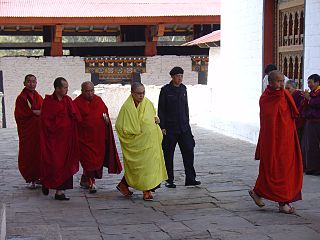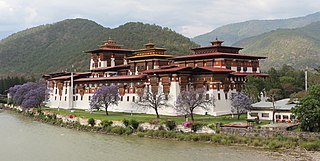The Catholic Church in Bhutan is part of the worldwide Catholic Church, under the spiritual leadership of the Pope in Rome. The Kingdom of Bhutan falls under the jurisdiction of the Diocese of Darjeeling (India).
| Part of a series on the |
| Catholic Church by country |
|---|
 |
| |
The Catholic Church in Bhutan is part of the worldwide Catholic Church, under the spiritual leadership of the Pope in Rome. The Kingdom of Bhutan falls under the jurisdiction of the Diocese of Darjeeling (India).
In 1627, two Portuguese Jesuits, Fathers Estêvão Cacella and João Cabral, traveling from Cochin and attempting to make a new route to the Jesuit mission in Shigatse, Tibet, [1] visited Bhutan. While in Bhutan, these Jesuits met Zhabdrung Ngawang Namgyal, the founder and religious leader of the Bhutanese state, and spent months in his court. The "Zhabdrung strongly encouraged the Jesuits to stay and even allowed them to use a room in Cheri [Monastery] as a chapel, granted them land in Paro to build a church and sent some of his own attendants to join the congregation. With no success in conversion and despite much discouragement from the Zhabdrung against their departure, the Jesuits eventually left for Tibet" [2] At the end of a stay of nearly eight months in the country, Cacella wrote a long letter from Cheri Monastery to his superior in Cochin in the Malabar Coast; it was a report, the Relação, relating the progress of their travels. Their visit is also corroborated in contemporaneous Bhutanese sources, including the biography of Zhabdrung Ngawang Namgyal himself. [3]
Two religious orders - the Jesuits in 1963 and the Salesians in 1965 - were invited to the country to open schools. The Salesians were expelled in February 1982 on disputed charges of proselytism. The only Catholic missionary allowed to stay in the country - from 1963 until his death in 1995 - was the Canadian-born Bhutanese Jesuit Father William Mackey, who opened several secondary schools and the pre-university Sherubtse College. As his mission was to build up a modern educational system in the country he did not attempt any conversions. [4]

In the early 2000s, there are thought to be about 1,000 Catholics in the country where Christians of all denominations are subject to discrimination. [5] In 2020, Catholics were estimated to make up 0.18% of the population, or approximately 1,500 people. [6]
The official religion is Buddhism and in the past Catholic missions have been denied entry. [7] [8]
On Palm Sunday, April 8, 2001, Bhutanese police went to churches and registered the names of believers and threatened one pastor with imprisonment after an interrogation. [9] It is illegal for Christians to hold public services. [10] The Constitution of Bhutan protects freedom of religion for Bhutanese citizens, but proselytism is forbidden. Article 7.4 states: "A Bhutanese citizen shall have the right to freedom of thought conscience and religion. No person shall be compelled to belong to another faith by means of coercion or inducement." [11]
The first Bhutanese-born Catholic priest, Rev Kinley Tshering, SJ, was ordained in 1986. He was initially dissuaded by missionaries but after a meeting with Mother Teresa he decided to become a Catholic priest. [12] As a citizen of the country, he travels freely in Bhutan, and celebrates the Christmas Mass under the pretext of his birthday on December 24. [13] He is also thought to be the first convert from Buddhism to the Christian faith in Bhutan. [14] In 2023, he is the only native-born priest. [15]
Bhutan has never had a native Catholic hierarchical jurisdiction, but is covered by the Diocese of Darjeeling. [16] [17]

Bhutan's early history is steeped in mythology and remains obscure. Some of the structures provide evidence that the region has been settled as early as 2000 BC. According to a legend it was ruled by a Cooch-Behar king, Sangaldip, around the 7th century BC, but not much is known prior to the introduction of Tibetan Buddhism in the 9th century, when turmoil in Tibet forced many monks to flee to Bhutan. In the 12th century, the Drukpa Kagyupa school was established and remains the dominant form of Buddhism in Bhutan today. The country's political history is intimately tied to its religious history and relations among the various monastic schools and monasteries.
The Drukpa or Drukpa Kagyu lineage, sometimes called Dugpa in older sources, is a branch of the Kagyu school of Tibetan Buddhism. The Kagyu school is one of the Sarma or "New Translation" schools of Tibetan Buddhism. The Drukpa lineage was founded in the Tsang region of Tibet by Tsangpa Gyare (1161–1211), and later became influential in Ladakh and Bhutan. It is one of several lineages known as "Red Hat sects".

Ngawang Namgyal and known colloquially as The Bearded Lama, was a Tibetan Buddhist lama and the unifier of Bhutan as a nation-state. In addition to unifying the various warring fiefdoms for the first time in the 1630s, he also sought to create a distinct Bhutanese cultural identity separate from the Tibetan culture from which it was derived.

The Chogyal were the monarchs of the former Kingdom of Sikkim, which belonged to the Namgyal dynasty. The Chogyal was the absolute monarch of Sikkim from 1642 to 1973, and the constitutional monarch from 1973 to 1975, when the monarchy was abolished and the Sikkimese people voted in a referendum to make Sikkim the 22nd state of India.

The Je Khenpo, formerly called the Dharma Raja by orientalists, is the title given to the senior religious hierarch of Bhutan. His primary duty is to lead the Dratshang Lhentshog of Bhutan, which oversees the Central Monastic Body, and to arbitrate on matters of doctrine, assisted by Five Lopen Rinpoches . The Je Khenpo is also responsible for many important liturgical and religious duties across the country. The sitting Je Khenpo is also formally the leader of the southern branch of the Drukpa Kagyu sect, which is part of the Kagyu tradition of Himalayan Buddhism. Aside from the King of Bhutan, only the Je Khenpo may don a saffron kabney.
Articles related to Bhutan include:

Zhabdrung was a title used when referring to or addressing great lamas in Tibet, particularly those who held a hereditary lineage. In Bhutan the title almost always refers to Ngawang Namgyal (1594–1651), the founder of the Bhutanese state, or one of his successive reincarnations.

Punakha is the administrative centre of Punakha dzongkhag, one of the 20 districts of Bhutan. Punakha was the capital of Bhutan and the seat of government until 1955, when the capital was moved to Thimphu. It is about 72 km away from Thimphu, and it takes about 3 hours by car from the capital. Unlike Thimphu, it is quite warm in winter and hot in summer. It is located at an elevation of 1,200 metres above sea level, and rice is grown as the main crop along the river valleys of two main rivers of Bhutan, the Pho Chu and Mo Chu. Dzongkha is widely spoken in this district.

Ralung Monastery, located in the Tsang region of western Tibet south of Karo Pass, is the traditional seat of the Drukpa Lineage of Tibetan Buddhism. It was founded in 1180 by Tsangpa Gyare, 1st Gyalwang Drukpa, a disciple of Lingje Répa who founded the Drukpa Lineage.
Ralung is one of the most sacred places in Tibet, for it is here that the great Dugpa school of red-hat monks originated, a school still influential with numerous adherents in Southern, Northern, and Eastern Tibet, and in Bhutan, which latter country is, in fact, called Dugpa owing to the preponderance of this sect. The Ralung-til, the head monastery of the Dugpa, is to the south-east of this village. This monastery owes its name to the fact that it is surrounded by mountains as the heart (mt'il) of a lotus is by the corolla.

The Wangchuck dynasty have held the hereditary position of Druk Gyalpo of Bhutan since 1907. Prior to reunification, the Wangchuck family had governed the district of Trongsa as descendants of Dungkar Choji. They eventually overpowered other regional lords and earned the favour of the British Empire. After consolidating power, the 12th Penlop of Trongsa Gongsar Ugyen Wangchuck was elected Druk Gyalpo, thus founding the dynasty. The position of Druk Gyalpo – who heads the royal family of Bhutan – is more commonly known in English as the King of Bhutan, however "Druk Gyalpo" would be translated literally as "Dragon King"

Christians are estimated to make up approximately 1% of the population in Bhutan, or approximately 8,000 people. Other figures suggest that they are more than 2% of the population.
The Druk Desi was the title of the secular (administrative) rulers of Bhutan under the dual system of government between the seventeenth and nineteenth centuries. Under this system, government authority was divided among secular and religious administrations, both unified under the nominal authority of the Zhabdrung Rinpoche. Druk, meaning 'thunder dragon', refers symbolically to Bhutan, whose most ancient name is Druk-yul. Desi, meaning 'regent', was the chief secular office in the realm under this system of government.

The Punakha Dzong, also known as Pungthang Dewa chhenbi Phodrang, is the administrative centre of Punakha District in Punakha, Bhutan. Constructed by Ngawang Namgyal, 1st Zhabdrung Rinpoche, in 1637–38, it is the second oldest and second-largest dzong in Bhutan and one of its most majestic structures. The dzong houses the sacred relics of the southern Drukpa Lineage of the Kagyu school of Tibetan Buddhism, including the Rangjung Kharsapani and the sacred remains of Ngawang Namgyal and the tertön Pema Lingpa.
Ngawang Namgyal was a prince of the Rinpungpa Dynasty that dominated Tsang in West Central Tibet between 1435 and 1565. He reigned from 1512 to 1544.
Public holidays in Bhutan consist of both national holidays and local festivals or tshechus. While national holidays are observed throughout Bhutan, tsechus are only observed in their areas. Bhutan uses its own calendar, a variant of the lunisolar Tibetan calendar. Because it is a lunisolar calendar, dates of some national holidays and most tshechus change from year to year. For example, the new year, Losar, generally falls between February and March.

The military history of Bhutan begins with the Battle of Five Lamas in 1634, marking Bhutan's emergence as a nation under the secular and religious leadership of Zhabdrung Ngawang Namgyal. Before Bhutan emerged as a separate nation, it remained on the periphery of Tibetan military and political influence. The region that became Bhutan was host to several battles and waves of refugees from turmoil in Tibet. After its founding, Bhutan was invaded numerous times by outside forces, namely Tibetans, Mongols, and the British. Bhutan meanwhile invaded its traditional tributaries in Sikkim, Cooch Behar, and the Duars.
Geshey Gendün Rinchen, was the 69th Je Khenpo of Bhutan.
Pagsam Wangpo, a key figure in the history of the Drukpa Lineage of Tibetan Buddhism, was born at Chonggye, in the Tsang province of Tibet a natural son of the prince of Chonggye, Ngawang Sonam Dragpa. He was an elder cousin of the 5th Dalai Lama, Ngawang Lobzang Gyatso (1617-1682).

Jigme Namgyel Wangchuck is the first child and heir apparent of King Jigme Khesar Namgyel Wangchuck of Bhutan and his wife, Queen Jetsun Pema. He has been the Crown Prince of Bhutan since his birth in 2016. His name was announced on 16 April 2016. Prior to the announcement, he was known only as The Gyalsey, which means "prince". Before his birth, his paternal uncle Prince Jigyel Ugyen of Bhutan was the heir presumptive to the throne. In honor of his birth, 108,000 trees were planted by thousands of volunteers in Bhutan. In 2017, in honor of his first birthday, a new damselfly species was named after the crown prince, Megalestes gyalsey. He is expected to become the sixth Druk Gyalpo.